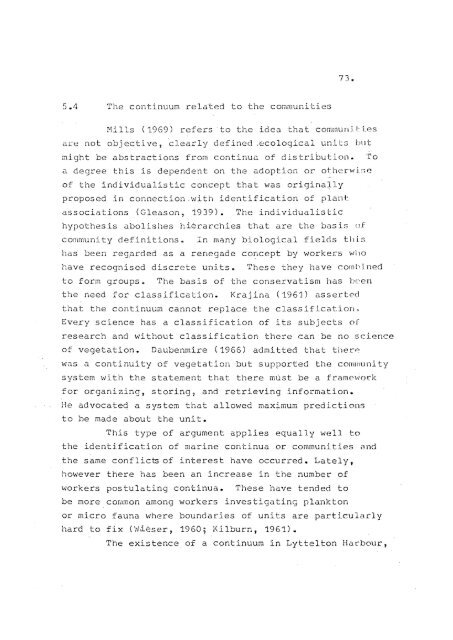The benthic ecology and community structure in Lyttelton Harbour ...
The benthic ecology and community structure in Lyttelton Harbour ...
The benthic ecology and community structure in Lyttelton Harbour ...
Create successful ePaper yourself
Turn your PDF publications into a flip-book with our unique Google optimized e-Paper software.
73.<br />
5.4 <strong>The</strong> cont<strong>in</strong>uum related to the communities<br />
Mill s (1969) ref e r s 't 0 t 11. e ide a t hat c ommu n j ,~;. e s<br />
are not objective, clearly def<strong>in</strong>ed .ecolog 1 units but<br />
might be abstractions from cont<strong>in</strong>ua of dIstribution. To<br />
a degree this is dependent on the adoptiDD or otherwi~e<br />
of the <strong>in</strong>dividualistic concept that was orig<strong>in</strong>a~ly<br />
proposed <strong>in</strong> connection.with identification of plant<br />
associations (Gleason, 1939). <strong>The</strong> <strong>in</strong>dividualistic<br />
hypothesis abolishes hierarchies that are the basis of<br />
<strong>community</strong> def<strong>in</strong>itions.. In many biological fields thi.s<br />
has been reg.arded as a renegade concept by workers \,r.,rho<br />
have recognised discrete units. <strong>The</strong>se they have comb<strong>in</strong>ed<br />
to form groups. <strong>The</strong> basis of the conse.rvatism has been<br />
the need for classification. Kraj<strong>in</strong>a (1961) asserted<br />
that the cont<strong>in</strong>uum cannot replace the classification ..<br />
Every science has a classification of its subjects of<br />
research <strong>and</strong> without classification there can be no science<br />
of vegetation. Daubenmire (1966) admitted that therp<br />
was a cont<strong>in</strong>uity of vegetation but supported the <strong>community</strong><br />
system with the statement that there m~st be a framework<br />
for organiz<strong>in</strong>g, stor<strong>in</strong>g, <strong>and</strong> retriev<strong>in</strong>g <strong>in</strong>formation.<br />
He advocated a system that allowed maximum predictions<br />
to be made about the unit.<br />
This type of argument applies equally well to<br />
the identification of mar<strong>in</strong>e cont<strong>in</strong>ua or communities <strong>and</strong><br />
the same conflicb of <strong>in</strong>terest have occurred. Lately,<br />
however there has been an <strong>in</strong>crease <strong>in</strong> the number of<br />
workers postulat<strong>in</strong>g cont<strong>in</strong>ua. <strong>The</strong>se have tended to<br />
be more common among workers <strong>in</strong>vestigat<strong>in</strong>g plankton<br />
or micro fauna where boundaries of units are particularly<br />
hard to fix (Wieser, 1960; Kilburn, 1961)~<br />
<strong>The</strong> existence of a cont<strong>in</strong>uum <strong>in</strong> <strong>Lyttelton</strong> <strong>Harbour</strong>,
















